 image by Ivan Sache, 28 March 2016
image by Ivan Sache, 28 March 2016
Last modified: 2024-03-02 by rob raeside
Keywords: education |
Links: FOTW homepage |
search |
disclaimer and copyright |
write us |
mirrors
See also:
Other Institutions:
 image by Ivan Sache, 28 March 2016
image by Ivan Sache, 28 March 2016
Colegio Militar Almirante Padilla (CMAP) is based in Soacha (Cundinamarca).
The institute is named for Admiral José Prudencio Padilla López (1784-1828),
hero of the independence of Gran Colombia from Spain and founder of the Navy of
Gran Colombia. Under his guidance, the Colombian Navy won its first battle in
Tolù (1815) and the decisive battle of Lake Maracaibo (24 July 1823). Allegedly
involved in the September Plot against Simon Bolívar (25 September 1828),
Padilla was sentenced to death and shot. The admiral was officially
rehabilitated in 1831 as an "innocent victim of tyranny".
The flag of the institute is horizontally divided white-blue. The colours
represent purity and the universe, respectively.
Source:
Institute
blog
Ivan Sache, 28 March 2016
 image by Ivan Sache, 12 August 2014
image by Ivan Sache, 12 August 2014
 image by Ivan Sache, 12 August 2014
image by Ivan Sache, 12 August 2014
Institución Educativa Almirante Padilla (INEALPA) was established in February
1943 in Riohacha (La Guajira Department), as as Departmental institute. This was
the first educational institute established in La Guajira. The institute was
nationalized by Law No. 20 of 23 November 1947. The institute is named for
Admiral José Prudencio Padilla López (1784-1828), who obtained on 1 December
1821 the surrender of the Spanish garrison of Cartagena and defeated the Spanish
troops on 24 July 1823 at Lake Maracaibo. Involved in the September Plot against
Simón Bolívar, Padilla was sentenced to death and executed.
The flag of the institute is shown in the institute's Constitution (PEI) as
horizontally divided white-blue.
White is a symbol of peace and heavens.
Blue is a symbol of the beauty of La Guajira peninsula, made of the
union of the sea and the sky.
However, the institute's emblem, also shown in the Constitution, features the
flag as horizontally divided blue-white, Photos of the flag in actual use seems
to indicate that the two versions are used.
Source:
http://inealpaquimica.jimdo.com/app/download/2098277718/PEI_INEALPA.pdf?t=1290522412
- Institute's Constitution
Photos:
http://inealpaquimica.jimdo.com/ and
http://jairojimenez2005.jimdo.com/actualidad-inealpistas-2011/
Ivan Sache, 12 August 2014
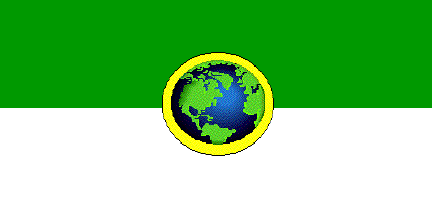 image by Ivan Sache, 03 December 2014
image by Ivan Sache, 03 December 2014
Institución Educativa Alonso Carvajal Peralta was established, as Escuela
Normal Rural de Chitagá (Norte de Santander Department), by Legislative Decree
No. 200 of 20 June 1958. The school was renamed Colegio Nacional de Varones by
Decree no. 2,025 of 12 October 1971. Colegio Integrado Nacional de Varones was
established in 2002 as the merger of Colegio Nacional de Varones, Colegio
Departamental Integrado Nuestra Señora del Carmen, Escuela Urbana Ramón González
Valencia, Escuela Urbana Trino García Peña and Núcleo Escolar Agrícola.
Institución Educativa Alonso Carvajal Peralta was eventually established by
Decree No. 823 of 30 September 2002.
The flag of the institute is horizontally divided green-white with a globe
surrounded by a yellow ring in the middle. Green is a symbol of hope, natural
environment, life and balance. White is a symbol of values, solidarity,
tolerance, autonomy, responsibility, peace, purity, quality, transparency,
sincerity and confidence. The yellow ring represents the mental resources, the
Earth's resources and the shield of protection we should build around it.
Source:
http://www.iealcarpe.edu.co/simbolos.html
Ivan Sache, 03 December 2014
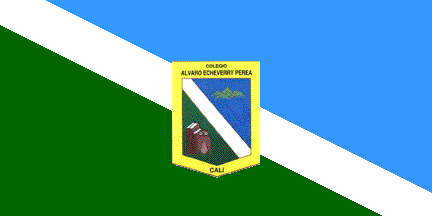 image by Ivan Sache, 26 November 2014
image by Ivan Sache, 26 November 2014
Institución Educativa Álvaro Echeverry Perea is located in Cali (Valle
Department).
The flag of the institute is divided blue-green by a white descending
diagonal stripe. In the middle is placed the institute's emblem.
Source: http://alvaroecheverrysaludable.blogspot.fr/ - Institute's blog
Photo:
http://2.bp.blogspot.com/_cf-2P3X4Xyg/SworbMmF1DI/AAAAAAAAAGs/fl60k6Bd42c/S254/d.jpg
Ivan Sache, 26 November 2014
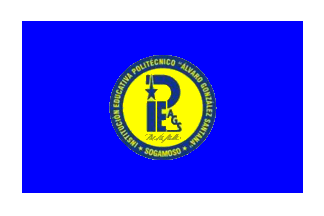 image by Ivan Sache, 28 July 2018
image by Ivan Sache, 28 July 2018
Institución Educativa Politécnico Álvaro González Santana was
established in Sogomaso (Boyacá) in 1988 by Municipal Agreement No. 23,
ratified on 14 September 1090 by Agreement No. 9.
The school is named for
Álvaro González Santana, lawyer and Professor of Economics at Lasalle
Universidad, who was murdered on 4 May 1989 in front of Bogotá National
Park. He was the father of judge Martha Lucía González, who had been
"appointed" Consul of Colombia in Indonesia - that is, exiled - in September
1988, after she had required the arrest of the drug warlords Pablo Escobar
and Gonzalo Rodríguez Gacha and of Fidel Castaño "Rambo", the chief of a a
paramilitary unit. The judge found significant evidence of collusion between
the drug barons, paramilitary groups, the official armed forces and state
officials in the onset of the War Drug that had started on 4 March 1988,
nine days before the municipal elections, when 20 farmers were murdered in
Turbo (Antioquia).
https://www.elespectador.com/noticias/nacional/un-padre-asesinado-una-jueza-exiliada-articulo-490281
El Espectador, 3 May 2014
The flag of IEP Álvaro González Santana is
described in the school's Manual de Convivencia as follows:
The flag
is composed of a blue rectangle bordered by a white rectangle. White
symbolizes the purity in thinking and being of all members of the Lasallian
community, taking as life's fundamental principle the truth that resides in
God's plenitude. The blue background, the color of the heavens, symbolizes
transcendence and God's residence, where we all shall go. The institute's
coat of arms is placed in the center of the flag.
The coat of arms is
surrounded by two concentric circles that symbolize the universality of
knowledge and the unity we shall build as the children of the same Father.
Inside, on a yellow background, are shown the initials of the institute's
name, a tribute to the scholar and martyr Álvaro González Santana. The
logo features the five-pointed Lasallian star, a symbol recognized worldwide
since the 18th century by all members of the Lasallian community, as the
star that guided the King Magi to the Gate of Bethlehem, where they met the
Savior. The star is also a symbol, a guide and a light that guides the
Lasallians to meet God and achieve their own salvation; a light that
enlightens darkness; and a shining post in the dark sky that invites us
every day to walk in faith, to live in fraternity, loving each other as
brothers, most of all those in greatest demand, to make all of our acts and
attitudes compliant with justice, and to live in a compromise with the
unconditional commitment of Lasallians to a better work.
https://www.politecnicoags.edu.co/wp-content/uploads/2017/05/MANUALDE-CONVIVENCIA-.pdf
Manual de Convivencia
Ivan Sache, 28 July 2018
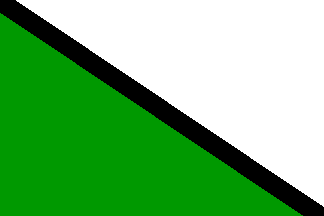 image by Ivan Sache, 27 September 2014
image by Ivan Sache, 27 September 2014
Institución Educativa Escuela Normal Superior Amagá is located in Amagá (Antioquia
Department).
The flag of the institute, designed by Luis Alberto Muñoz Pulgarín, Miriam
Cecilia Rivera, and Blanca Rosa Gómez Acevedo, was adopted on 10 September 1974.
The flag is diagonally divided white-green by a black descending diagonal stripe.
White is a symbol of honour and light.
Green is a symbol of forest resources and hope.
Black is a symbol of rigour, discipline, and carbon.
Source:
http://normalamaga.edu.co/simbolos_institucionales.html - Institute's
website
Ivan Sache, 27 September 2014
 image by Ivan Sache, 19 September 2014
image by Ivan Sache, 19 September 2014
"Institución Educativa Agroecológico Amazónico"
was created in the village of La Niña, Municipality of El
Paujil, Department of Caquetá, on 3 December 2003 (Decree No.
603), through the merging of "Concentración John F.
Kennedy", "Colegio San Luis Gonzaga" and
"Collegio Agroecológico Amazónico" (founded on 4
December 1995, Decree No. 1003).
The flag of the institute, as shown graphically on the website
of the institute, is horizontally divided green-white-blue
(1:2:1).
Ivan Sache, 30 January 2009
The updated version of the institute's website shows the flag with equal
horizontal stripes.
Source:
http://agroecologicopaujil.edu.co/institucional/
However, photos of the flag in actual use seem to indicate that the white stripe
is slightly broader than the other ones [but not as broad as on the image
previously reported].
Source:
http://agroecologicopaujil.edu.co/blog/el-colegio-agroecologico-en-el-7-de-agosto/
Ivan Sache, 19 September 2014
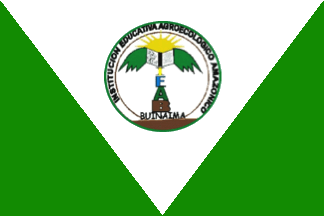 image by Ivan Sache, 25 September 2014
image by Ivan Sache, 25 September 2014
Institución Educativa Agroecológico Amazónico Buinaima is located in
Florencia (Caquetá Department).
The flag of the institute, designed by Rosa Elena Murcia Musse, is of dimension
1.80 m x 1. 20 m. The flag is white with two forest green right-angled triangles
placed at the bottom, and the institute's emblem in the middle. White is a
symbol of social peace and institutional transparency. Forest green is a symbol
of ecology and Amazonian exuberance.
The emblem of the institute is circular, as a symbol of unity and holiness,
representing the institute's vision for Amazonian ecology. The name of the
institute is written on the ring limiting the emblem. The emblem features a
schematized palm tree, as a symbol of Amazonia, the world's lung, whose foliage
is made of an open book ending with leaves at each end. The book is printed with
the "institutional vision" on the left page and with the "mission" on the right
page. The shoot of the palm tree is made of the coloured initials of the name of
the institute, with the following meaning:
- "I", for "Institución", yellow, as a symbol of intelligence and knowledge;
- "E", for "Educativa", blue, as a symbol of ecological topics: the water and
the atmosphere of Amazonia;
- "A", for "Agroecológico Amazónico", forest green, as a symbol of the Amazonian
forest;
- "B", for "Buinaima", coffee brown, as a symbol of the soil, a central
component of any ecological relation.
Beneath the palm tree, the word "BUINAIMA" forms small roots, in contact with a
coffee brown sector, as a symbol of the soil in which stands the palm tree and
which supports the Amazonian exuberance. The palm is ensigned with a rising sun,
as a symbol of light, science, and, specifically, life in all its components,
whose relations are the object of ecological studies.
Source:
http://institucioneducativabuinaima.jimdo.com/ - Institute's website
Ivan Sache, 25 September 2014
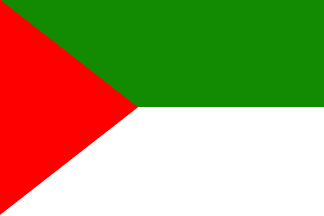 image byIvan Sache, 3 January 2021
image byIvan Sache, 3 January 2021
Colegio Gimnasio América was established on 9 February 1963 in Montería
(Córdoba) by Maria Salcedo de Negrete, as Gimnasio Feminino América,
subsequently renamed to Gimnasio América Mixto. The school was acquired in 1987
by Edith del Carmen Aguirre Casarrubia.
The flag of Colegio Gimnasio América is horizontally divided green-white with a white triangle placed along
the hoist.
Green represents hope.
White represents mind greatness.
Red represents love and civism.
Source: school website
Ivan Sache, 3 January 2021
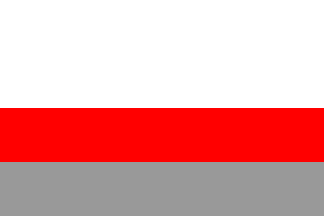 image by Ivan Sache, 13 May 2021
image by Ivan Sache, 13 May 2021
Institución Educativa América is located in Puerto Berrío (Antioquia).
The flag of IE América is horizontally divided (2:1:1) white-red-gray
with a blue border all around.
White represents the institution's values.
Red means force and sacrifice of the members of the educative community
to achieve his/her duty.
Gray represents knowledge, the academic, the scientist, the researcher
and the technologist who allow the development of cognitive skills
required to the achievement of the Colombian educative system.
Blue represents understanding.
school blog
Ivan Sache, 13 May 2021
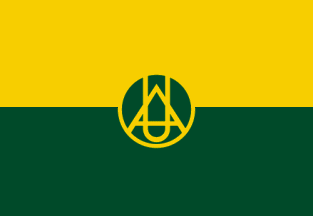 image by
Randy Young, 07 February 2016
image by
Randy Young, 07 February 2016
"The Fundación Universidad de América was established as Escuela de
Arquitectura (School of Architecture) in 1956. It is a private, nonsectarian,
coeducational research university located in
Bogotá "
Sources: http://www.uamerica.edu.co/la-universidad/historia/ and
https://es.wikipedia.org/wiki/Universidad_de_Am%C3%A9rica
For additional information go to: Universidad de América (official websites)
Its flag is a horizontal flag equally divided int two stripes, the top
part being yellow and the bottom gree, with the
logo in the
middle, as seen
here and
here.
Esteban Rivera, 07 February 2016
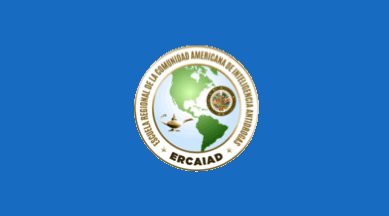 image by
Ivan Sache, 22 March 2019
image by
Ivan Sache, 22 March 2019
Regional School of the American Community of Anti-Drug Intelligence (Escuela
Regional de la Comunidad Americana de Inteligencia Antidrogas - ERCAIAD) is
located in borough Fátima, Bogotá. ERCAIAD is commissioned to execute the
proposals and compromises prescribed in the memorandum signed on 21 March 2012
by the Organization of American States and the Government of Colombia.
The flag of ERCAIAD is blue with the school's logotype in the center. The
logotype of ERCAIAD is shaped like a circular seal surrounded by two golden
circles. The border is inscribed with the school's full name, the acronym
"ERCAIAD" being inscribed in the lower part in bolder letters. In the center is
featured the Earth, blue and green, showing in full North, Central and South
America. On the left side, an oil lamp represents enlightenment, as a symbol of
knowledge and intelligence; on the right side is placed the coat of arms of the
Organization of American States.
https://www.policia.gov.co/unidades/simbolos/3923
Ivan Sache, 22 March 2019
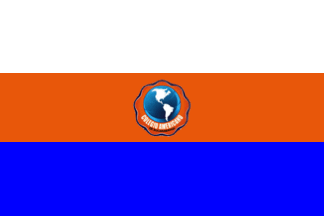 image by
Ivan Sache, 3 January 2021
image by
Ivan Sache, 3 January 2021
Colegio Americano in Bucaramanga (Santander) is managed by the Presbyterian
Church of Colombia.
The flag of Colegio Americano is horizontally divided
white-orange-blue with the school's emblem in the center.
White represents
integrity and transparency of a life renewed in Christ.
Orange represents
glee and the Gospel's light.
Blue represents the divine protection under a
clam blue sky, the force of knowledge and the power of the heights. "The heavens
declare the glory of God" (Psalm 19:1).
The emblem is composed of a map
of America, recalling the school's name, surrounded by blue sea, as the Sea of
Knowledge. The map emerges from water as the result of a renovated education,
surrounded by new waves representing the fruit of the Holy Spirit.
http://www.colegioamericanobga.com/micolegio/20002cx.php
School website
Photos
http://www.colegioamericanobga.com/micolegio/20003cx.php
Ivan Sache, 3 January 2021
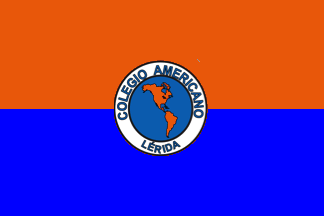 image by
Ivan Sache, 3 January 2021
image by
Ivan Sache, 3 January 2021
Colegio Americano in Lérida (Tolima) is managed by the Presbyterian Church of
Colombia.
The flag of Colegio Americano is horizontally divided
orange-blue with the school's emblem in the center.
Orange represents the
Gospel's light.
Blue represents the water of the oceans that brought
missionaries to the American continent and river Magdalena that allowed them to
navigate northwards on canoes and fund churches and schools.
The emblem
is composed of a map of America, recalling the school's name, surrounded by blue
sea, as the Sea of Knowledge. The map emerges from water as the result of a
renovated education, surrounded by new waves representing the fruit of the Holy
Spirit.
https://colegioamericanolerida.wordpress.com/simbolos-de-la-institucion
School website
Ivan Sache, 3 January 2021
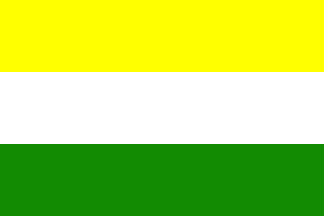 image by
Ivan Sache, 12 October 2018
image by
Ivan Sache, 12 October 2018
Colegio Superior Americano (CSA) is located in borough Las Américas, Bogotá.
The flag of CSA is horizontally divided yellow-white-green. Yellow
represents abundance, spiritual resources and human touch. White represents
peace, harmony, tranquility and purity. Green represents hope.
http://www.superioramericano.edu.co/index.php/colegio/simbolos
Ivan
Sache, 12 October 2018
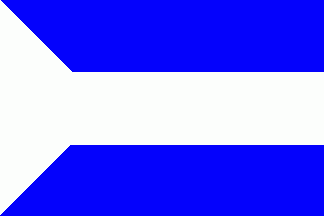 image by Jairo Alonso Méndez Méndez, 14 November 2004
image by Jairo Alonso Méndez Méndez, 14 November 2004
Colegio Americano Menno (La Mesa, Cundinamarca).
Jairo Alonso Méndez Méndez, 14 November 2004